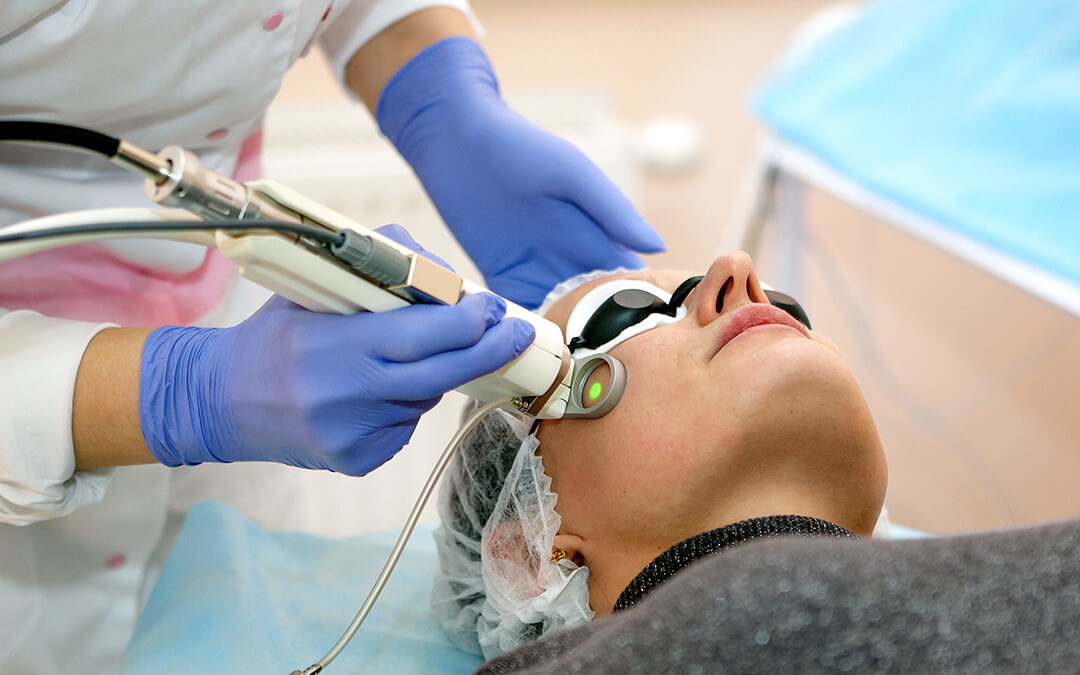Modern dermatology is known for its inventive procedures and services. From botox injections to reduce fine lines and wrinkles to the “vampire facial” that uses your own blood, there are a host of treatments available to people today to help them keep their skin looking fresh. Recently, CO2 laser resurfacing has emerged as a top dermatology treatment.
What Is CO2 Laser Resurfacing?
Designed to minimize wrinkles, reduce facial scarring, and even out skin tone, CO2 laser resurfacing takes carbon dioxide and uses it to resurface the skin. During the procedure, thin layers of skin are vaporized using a high-energy beam of laser light. This vaporizing helps to produce collagen and restore skin elasticity, leading to an improved look. Because of the laser, CO2 laser resurfacing can be more effective than other treatments like dermabrasion or microneedling.
Why Carbon Dioxide?
For this treatment, a mixture of three gases is used. This consists of 10%–20% carbon dioxide and 10%–20% nitrogen, with the remainder being helium. This mixture is used in tandem with a laser that emits a wavelength of high-energy light. When focused on a certain skin condition or body part, the laser will create heat and destroy the diseased or old cells.
There are various kinds of lasers available, and they all do different things. The differentiation comes from the medium that produces the laser beam. A medium amplifies the light of a particular wavelength as it passes through it. By using CO2 during laser resurfacing treatments, the laser produces a specific wavelength of light in the infrared spectrum (10,600 nm), which is conducive to the treatment of certain skin conditions.
How Does CO2 Laser Resurfacing Work?
Ultimately, the goal of this procedure is to produce a beautiful, even skin texture while avoiding any scarring and lightening of the skin. During treatment, carbon dioxide laser beams penetrate the top skin layers reaching into the dermis. This creates a “controlled injury” to the skin, or tiny microscopic areas of thermal damage, which stimulate new collagen production and replace damaged skin surfaces with new epidermal cells. It can be done on an entire face or specific areas.
What Is It Used For?

The U.S. Food and Drug Administration (FDA) has approved CO2 laser resurfacing as a way to treat skin disorders. Various skin disorders can be treated with CO2 laser resurfacing:
- Raised birthmarks
- Moles
- Viral warts
- Acne scarring
- Keloid and hypertrophic scars
- Skin aging
- Facial lines and wrinkles
- Stretch marks
- Uneven pigments like melasma and freckles
Why Is It Good?
While it’s not a cheap treatment (the average cost tends to run about $2,000 and $5,000 per session), there are several benefits to carbon dioxide laser treatments. For dermatology, it provides a highly precise way to deliver treatment to typically small areas. CO2 lasering is less invasive than alternative treatments such as dermabrasion and chemical peeling, with a short recovery time of about two weeks. Results can be seen as soon as three to six months after treatment, once the skin is fully healed.
Side Effects
Side effects for CO2 laser resurfacing are relatively minor and tend to go away in a short time. The most common side effects include swelling, redness, and irritation at the site. However, burning, scarring, and a change in pigmentation can occur. CO2 laser treatment may also be unsuitable for:
- Patients with a tendency to form keloid and hypertrophic scars
- People with connective tissue diseases
- People with HIV or hepatitis C infections
All in all, CO2 laser resurfacing can help people to look and feel great, improving their skin while boosting self-esteem and confidence. And at CalOx, we can provide the carbon dioxide for dermatology practices needed for CO2 laser treatment procedures. We provide everything you need to safely store and use CO2 at your own dermatology practice. Contact us today for your quote!
Sources:
https://dermnetnz.org/topics/carbon-dioxide-laser-treatment
https://www.usdermatologypartners.com/services/cosmetic-dermatology/co2-laser-resurfacing/
